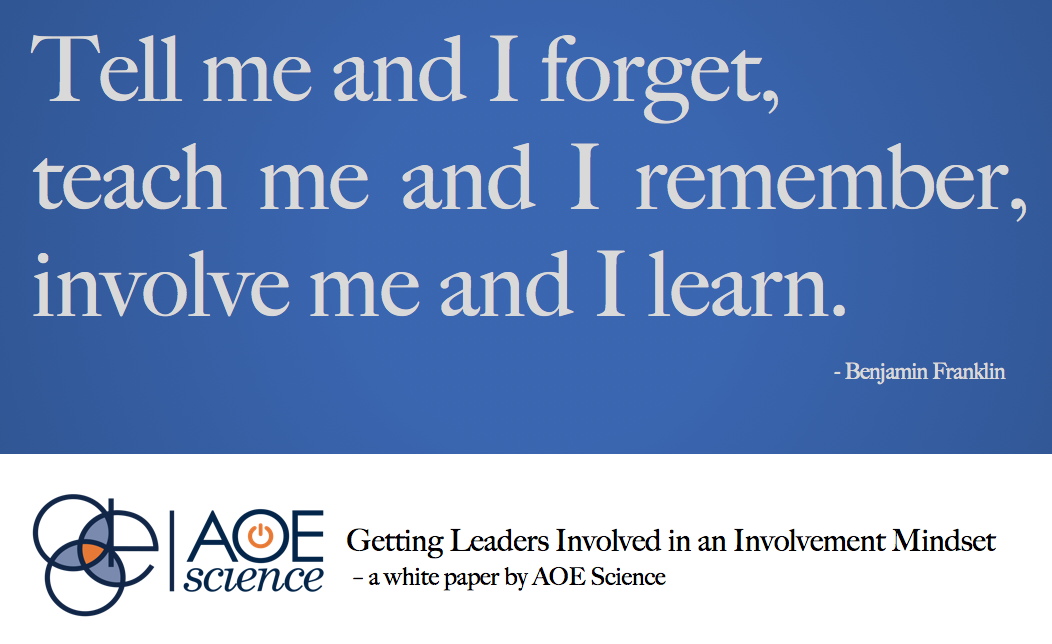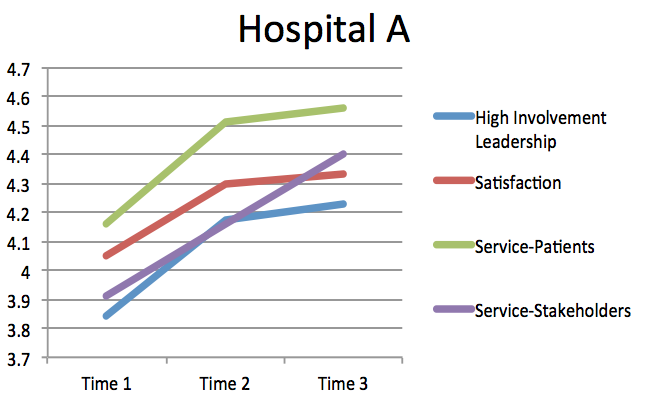Getting Leaders Involved in an Involvement Mindset
-

Why Involvement?
Often organizations are faced with competing demands. Should we focus on this part of the market or that part of the market, this product or that product? When it comes to your most valued stakeholders, organizations sometimes create an artificial choice: customers or employees. Most top-level leaders will see that the focus should be on both. However, in practice, most of the focus is given to the customer. Focusing on customers at the expense of employees leads to a ‘competing values’ framework which can hurt the overall performance of the organization, as well as each and every stakeholder (customer and employee).Based upon the work in high involvement systems, we have taken the pioneering work of Dr. Edward Lawler and transformed it into a platform in which leaders are developed to ‘be involved with involving their employees’. AOE’s High Involvement Leadership Program has been shown to overcome a competing values framework. Within this framework, leaders are trained to develop a culture of employee engagement and reduce competing values. The primary goal of AOE’s High Involvement Leadership Program is to build involvement in supervisors, which spreads to involvement in groups and results in better performance, increased employee attitudes, and loyalty. Our framework is highly sustainable – demonstrating positive growth for over 15 months since initial launch at two different hospitals. Our work in this area lead to the development of two proprietary assessments for AOE Science (i.e., The Organizational Well-Being Index®, and the AOE-L®).
AOE Involvement Mindset:
For years AOE has worked with a leading healthcare provider across the United States, Called ABC[1]. Results from our initial partnership revealed employee concerns of an imbalance in focus on employees and patients. The employees acknowledged and believed in the emphasis placed on patient service. This was evident as the hospital continuously received industry leading patient satisfaction and service scores. Yet, employees felt that the strong focus on patients often dissuaded the focus on hospital employees. Employee needs were not being met at the same level of the patients. Hence, a competing values framework.Data were collected at three time points from ABC employees at two hospitals in the United States. We subsequently performed analyses to determine the growth trajectories (Figures 1 & 2) and differences in overall means across the three times (Tables 1 & 2). We observed significant growth across the yearlong period. This growth was attributable to the Involvement Development Sessions conducted with each manager at ABC between each survey administration.
Leaders were developed on Involvement and assisted with institutingInvolvement within their respective group. Most amazingly, ABC was already trending towards the top end of the scale, and AOE’s Involvement Framework pushed them further towards the top!

[1] ABC is used to protect the confidentiality of our client.
The results from ABC were indicative of the effects of AOE’s intervention – later termed ‘High Involvement Leadership’ (HIL). For instance, the HIL coaching and feedback reports, which were expected to increase stakeholder involvement in their work, were successful in building involvement and increasing satisfaction and service to both patients and employees. Although patient service was already high at ABC, HIL reduced the tradeoff between patient satisfaction and employee satisfaction. Instead, the growth patterns shown in Figures 1 & 2 reveal that the gap between service for patients and service for employees was effectively reduced by AOE’s Involvement Framework. Furthermore, the discrepancy between service to patients and service to employees was reduced from a large statistical gap to a very small gap at both hospitals. Overall, AOE’s Framework supports significant growth from time 1 to time 3.
 Conclusion:
Overall, the important conclusion is that we observed significant positive growth in both employee and patient satisfaction and performance. This is a very interesting finding as many consider the competing values framework to be a tradeoff whereby an emphasis on employees reduces an emphasis on customers. Our data at ABC revealed this to be untrue – if careful action is taken. Both patient and employee service can be improved. As a result of our work, AOE Science developed The Organizational Well-Being Index® that organizations can use to gauge how involvement is working. The Organizational Well-Being Index provides information on an organization’s culture, leadership, teamwork, and morale. Because of the popularity of the HIL framework we focused our efforts on the leadership aspect and developed and validated the AOE-L®. The AOE-L is a leadership development assessment specific to developing involvement in organizational leaders. These assessments greatly compliment AOE’s leader selection tools allowing organizations to scientifically select AND develop leaders.
Conclusion:
Overall, the important conclusion is that we observed significant positive growth in both employee and patient satisfaction and performance. This is a very interesting finding as many consider the competing values framework to be a tradeoff whereby an emphasis on employees reduces an emphasis on customers. Our data at ABC revealed this to be untrue – if careful action is taken. Both patient and employee service can be improved. As a result of our work, AOE Science developed The Organizational Well-Being Index® that organizations can use to gauge how involvement is working. The Organizational Well-Being Index provides information on an organization’s culture, leadership, teamwork, and morale. Because of the popularity of the HIL framework we focused our efforts on the leadership aspect and developed and validated the AOE-L®. The AOE-L is a leadership development assessment specific to developing involvement in organizational leaders. These assessments greatly compliment AOE’s leader selection tools allowing organizations to scientifically select AND develop leaders.
Learn more about AOE Assessments for Leadership and Organizational Well-Being here: https://aoescience.com/aoe-assessments-overview/